Rivian Bundle
How Does Rivian Conquer the EV Market?
Rivian's entrance into the electric vehicle arena with its R1T pickup truck was a bold statement, immediately carving out a niche with its 'Electric Adventure Vehicle' concept. Founded in 2009 by R.J. Scaringe, Rivian has consistently challenged the status quo, focusing on sustainability and performance. This introduction delves into the core of Rivian's strategy, exploring how it has built its brand and engaged its customers.
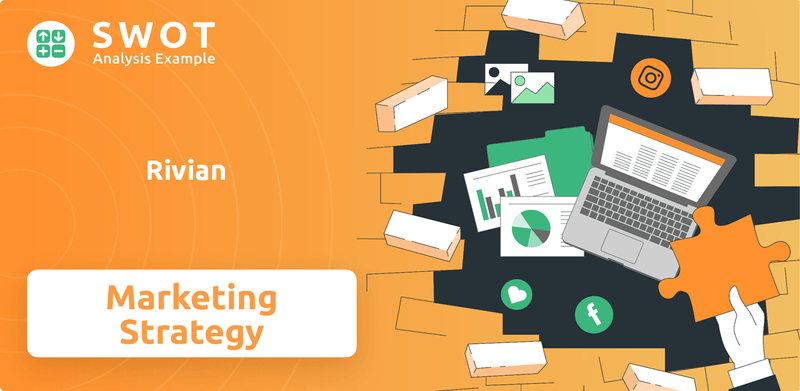
This analysis will dissect Rivian's Rivian SWOT Analysis, sales process for R1T, and marketing campaign examples, revealing how it has cultivated a loyal customer base and positioned itself for future growth. We'll examine Rivian's go-to-market approach, including its direct-to-consumer model, digital marketing efforts, and customer acquisition strategies, providing a comprehensive Rivian market analysis. Understanding Rivian's sales strategy and Rivian marketing strategy is crucial for anyone seeking to understand the dynamics of the EV market and the power of effective brand positioning.
How Does Rivian Reach Its Customers?
The sales strategy of the company primarily revolves around a direct-to-consumer (DTC) model. This approach allows the company to control the customer experience, pricing, and service quality. Customers can purchase vehicles like the R1T and R1S directly through the company's website, offering a streamlined and transparent buying process.
This direct sales model is complemented by physical retail locations, known as 'Rivian Spaces,' where potential customers can experience the vehicles firsthand. These spaces serve as showrooms and test-drive centers, enhancing the customer journey. The company's marketing strategy emphasizes digital channels and experiential retail to build brand awareness and drive sales.
The company's go-to-market strategy has evolved to navigate state-level franchise laws. The company's sales process is designed to provide a seamless experience, from online configuration to direct delivery. The company is also expanding its service infrastructure to support its growing customer base.
The company's website serves as the primary sales channel, allowing customers to configure and order vehicles. The online platform provides real-time customization options and estimated delivery timelines. This digital-first approach streamlines the purchasing process and offers convenience to customers.
The company operates physical retail locations, or 'Rivian Spaces,' where customers can see and test drive vehicles. As of January 2024, there were 24 retail locations. The company plans to expand these locations to over 40 by the end of 2025. These spaces enhance the customer experience and build brand awareness.
The company is expanding its service infrastructure to support its direct sales model. The goal is to have over 100 new Service Centers by the end of 2025, in addition to the current 59 active centers. Mobile service technicians handle over half of current service visits, providing convenient post-purchase support.
The company has partnerships, such as the one with Amazon for Electric Delivery Vans (EDVs). In 2024, Amazon delivered over 1 billion packages in Rivian EDVs in the U.S. The company's access to Tesla's North American Charging Standard (NACS) network will make its vehicles more appealing. These collaborations enhance the company's market reach.
The company's sales strategy is designed to provide a seamless customer experience while navigating regulatory hurdles. The expansion of service centers and the use of mobile technicians are key components of the post-purchase support system. The company's partnerships and collaborations, like the one with Amazon, are also important for market penetration. For more insights, you can explore the Competitors Landscape of Rivian.
The company's sales strategy focuses on direct-to-consumer sales, leveraging both online and physical retail channels. The company's marketing efforts are primarily digital, with a focus on building brand awareness and driving sales through online platforms and experiential retail. The expansion of service centers and mobile service options enhances customer support.
- Direct-to-consumer sales model
- Online configuration and ordering
- Physical retail locations for test drives
- Expansion of service infrastructure
- Strategic partnerships and collaborations
Rivian SWOT Analysis
- Complete SWOT Breakdown
- Fully Customizable
- Editable in Excel & Word
- Professional Formatting
- Investor-Ready Format
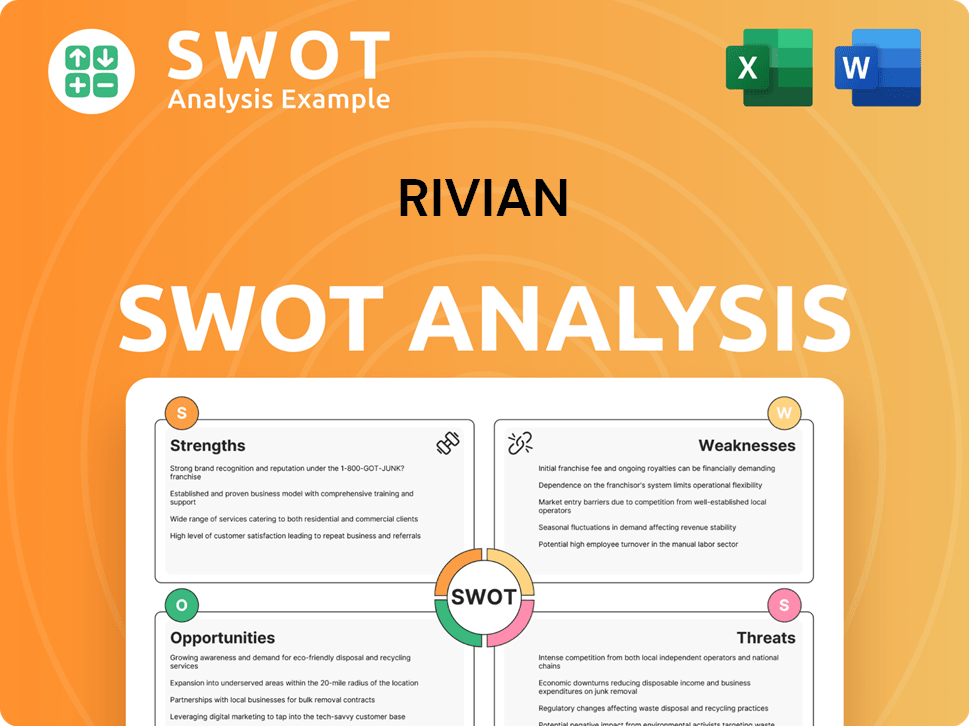
What Marketing Tactics Does Rivian Use?
The marketing tactics employed by the company are multifaceted, emphasizing sustainability, innovation, and the adventurous spirit associated with its electric vehicles. This 'offensive strategy' targets early adopters and adventure-seeking consumers, particularly highlighting the off-road capabilities of its vehicles. The approach is designed to build brand awareness and drive sales within a competitive market.
Digital platforms and experiential marketing play crucial roles in the company's strategy. The company leverages social media, digital advertising, and content marketing to engage its target audience. Additionally, it invests in immersive experiences and collaborations to enhance brand recognition and expand its customer reach. The company's marketing efforts are data-driven, aiming to create a cohesive brand narrative across all touchpoints.
Traditional media and event participation also contribute to the company's marketing mix. Showcasing vehicles at automotive and technology conferences and employing a dedicated marketing team are integral parts of the strategy. The company focuses on connecting its brand storytelling from digital platforms to in-person experiences and through to vehicle ownership.
Digital marketing is a core component of the company's strategy. The company maintains an active presence on social media platforms. Digital advertising is a significant part of the budget.
As of January 2024, the company had a significant presence on social media. The company leverages platforms like Instagram, Twitter/X, LinkedIn, and YouTube. These platforms are used for brand visibility and audience engagement.
Digital advertising efforts allocate a significant portion of the budget. In 2024, the budget was distributed across different platforms. Google Ads received 42%, Meta Platforms 33%, YouTube 15%, and LinkedIn 10%.
Content marketing is used to showcase the vehicles in adventurous settings. This strategy appeals to outdoor enthusiasts. It helps in building brand awareness and engagement.
Influencer collaborations are a key tactic for the company. Partnerships with outdoor and technology content creators are common. These collaborations enhance brand recognition and expand customer reach.
Experiential marketing includes initiatives like the 'Concept Experience' in New York City. These immersive spaces offer interactive features and 'adventure drives'. This approach provides firsthand engagement with the brand's values.
The company's approach to marketing is multifaceted, focusing on digital strategies, influencer collaborations, and experiential marketing to build brand awareness and drive sales. The company also utilizes traditional media and events to reach a wider audience. For a deeper dive into the company's target demographic, consider exploring the Target Market of Rivian.
The company employs a mix of digital and traditional marketing tactics to reach its target audience. The company focuses on building brand awareness through various channels. The marketing strategy emphasizes the unique features and values of the brand.
- Digital Marketing: Active social media presence on platforms like Instagram (with 315,000 followers as of January 2024), Twitter/X (218,000 followers), LinkedIn (142,000 followers), and YouTube (87,000 subscribers).
- Digital Advertising: Budget allocation in 2024: 42% to Google Ads, 33% to Meta Platforms, 15% to YouTube, and 10% to LinkedIn.
- Content Marketing: Creation of content showcasing vehicles in adventurous settings.
- Influencer Collaborations: Partnerships with outdoor and technology content creators (with 47 active brand ambassadors as of January 2024).
- Experiential Marketing: 'Concept Experience' in New York City with interactive features.
- Traditional Media and Events: Participation in automotive and technology conferences like CES (173,000 attendees in 2024) and the North American International Auto Show (82,000 attendees in 2024).
- Brand Campaign: The first full-fledged brand campaign, 'Real Rivian Adventures,' includes CTV, YouTube, and potential broadcast advertising.
Rivian PESTLE Analysis
- Covers All 6 PESTLE Categories
- No Research Needed – Save Hours of Work
- Built by Experts, Trusted by Consultants
- Instant Download, Ready to Use
- 100% Editable, Fully Customizable
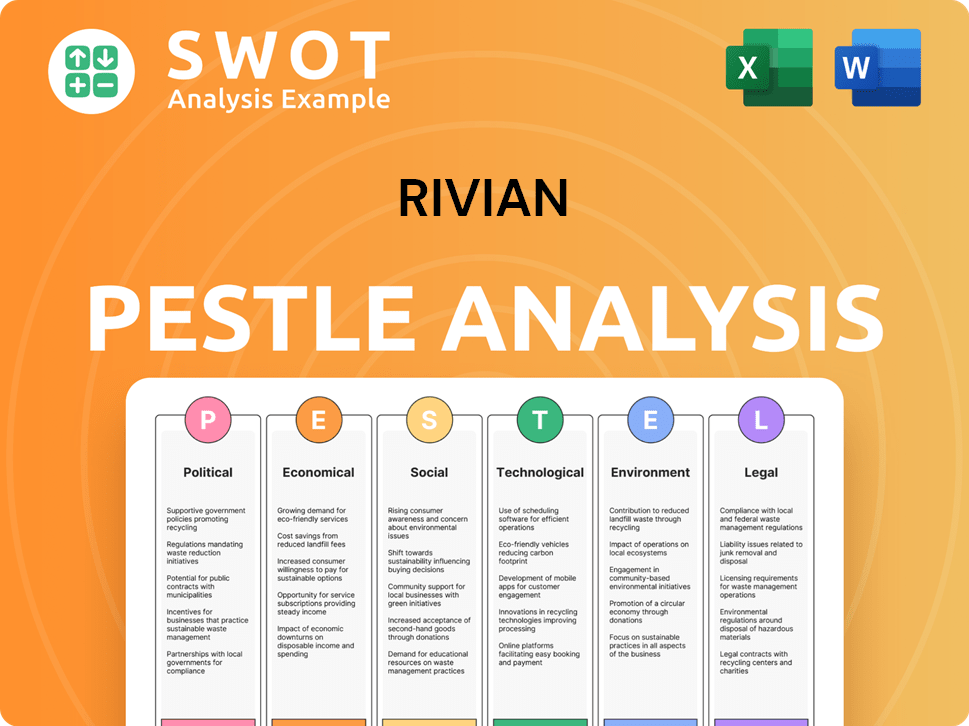
How Is Rivian Positioned in the Market?
The brand positioning of Rivian is centered around adventure, sustainability, and innovation, aiming to redefine the electric vehicle (EV) landscape. This strategy focuses on appealing to environmentally conscious consumers and outdoor enthusiasts. The core message emphasizes exploring the world while minimizing environmental impact, reflected in the design and functionality of their vehicles.
Rivian's visual identity is modern and clean, with a custom typeface and a compass logo symbolizing adventure. Their tone of voice is inspiring, aligning with their mission to improve the world through innovation and adventure. This approach helps in building a strong brand image that resonates with its target audience.
Rivian differentiates itself by focusing on the 'Electric Adventure Vehicle' category, targeting outdoor enthusiasts. This unique selling proposition combines performance and sustainability. Their commitment to sustainability is evident in their manufacturing processes and the use of sustainable materials. This holistic approach strengthens their brand image and customer loyalty.
Rivian's Rivian sales strategy centers on the 'Electric Adventure Vehicle' category. This unique positioning distinguishes them from traditional truck and SUV manufacturers. This focus caters to a niche market of outdoor enthusiasts who prioritize both performance and sustainability.
Sustainability is deeply ingrained in Rivian's brand. This includes using renewable energy in manufacturing and sustainable materials in their vehicles. This commitment enhances their brand image and appeals to environmentally conscious consumers, which is a key element of their Rivian marketing strategy.
Rivian fosters a community of passionate customers, contributing to brand loyalty. This community engagement is crucial for Rivian's customer acquisition strategies and overall brand awareness. This approach helps in building a loyal customer base.
The company engages in strategic partnerships with outdoor adventure brands and environmental organizations. These collaborations enhance credibility and expand their reach to the target audience. These partnerships are a key part of their Rivian go-to-market strategy.
Rivian has achieved high customer satisfaction, ranking #1 in 2023 and 2024. This indicates the success of their brand appeal and customer experience. This high level of satisfaction contributes to strong brand loyalty and positive word-of-mouth marketing.
- Rivian's customer relationship management is a key factor in maintaining high satisfaction levels.
- The focus on design, performance, and versatility helps appeal to a broader market.
- Their responsive approach to consumer sentiment is crucial for long-term success.
- For more information, check out the Brief History of Rivian.
Rivian Business Model Canvas
- Complete 9-Block Business Model Canvas
- Effortlessly Communicate Your Business Strategy
- Investor-Ready BMC Format
- 100% Editable and Customizable
- Clear and Structured Layout
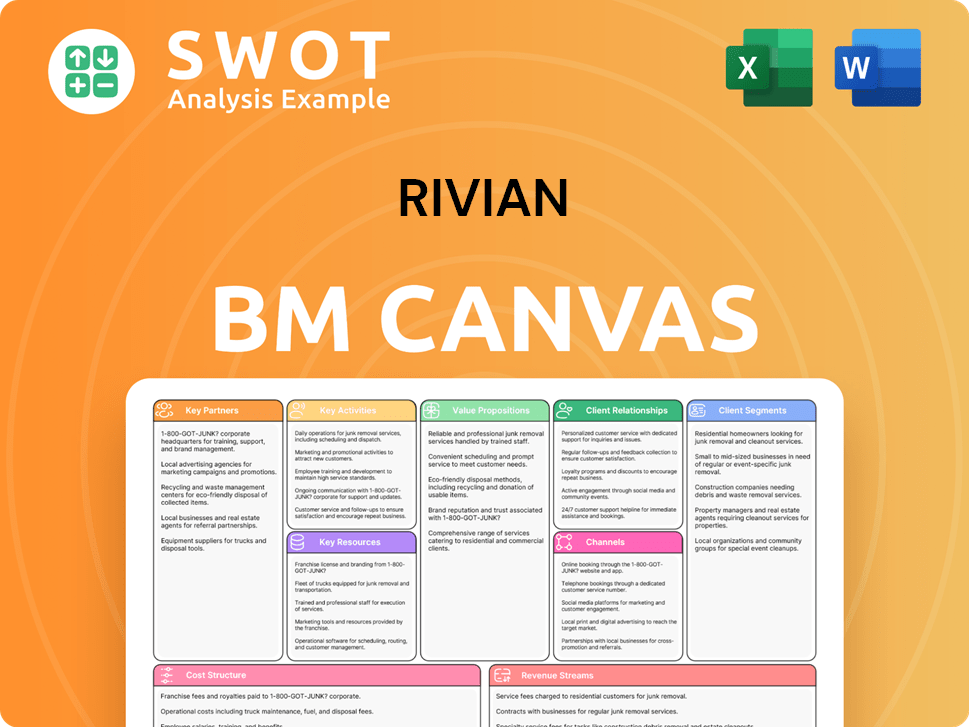
What Are Rivian’s Most Notable Campaigns?
Rivian's marketing strategy has recently gained significant momentum with the launch of its national brand campaign, 'Real Rivian Adventures,' in May 2025. This campaign is a pivotal move to boost brand awareness, particularly ahead of the R2 SUV's planned debut in early 2026. The R2, designed for a broader market, is expected to have a retail price around $45,000, contrasting with the R1T pickup, which starts at nearly $70,000, and the R1S SUV, priced from $75,900.
The 'Real Rivian Adventures' campaign focuses on showcasing real customer stories to build a strong brand identity. The campaign differentiates Rivian by positioning it as a lifestyle brand that promotes adventure. The initial ad, 'Last Lemonade Standing,' is based on a real customer's experience and highlights the practical features of the R1T. The campaign is broadcast on CTV and YouTube, with potential for further expansion.
Before this national campaign, Rivian's marketing relied heavily on its products and the strong loyalty of early EV adopters. Rivian's go-to-market strategy has evolved, aiming to reach a wider audience and increase sales. The company is actively working to enhance its customer acquisition strategies.
The primary goal of 'Real Rivian Adventures' is to connect with potential customers by sharing authentic stories from actual owners, demonstrating the practicality and appeal of Rivian's electric vehicles.
The campaign is targeted at a broader audience, including those interested in adventure and lifestyle, not just early adopters. This approach helps Rivian build brand awareness and expand its market reach.
The campaign's key message is that Rivian vehicles enable everyday adventures. This is achieved through cinematic advertisements that feature real-life customer experiences, reinforcing the brand's lifestyle positioning.
The 'Real Rivian Adventures' campaign utilizes CTV and YouTube for distribution, with the potential for additional broadcast channels. This multi-channel approach helps Rivian reach a wider audience and strengthen its digital marketing efforts.
Rivian's 2024 deliveries totaled 51,579 vehicles. In 2025, Rivian has reaffirmed its delivery target of 46,000–51,000 vehicles. The company achieved a gross profit of $170 million in Q4 2024. Rivian's Q1 2025 production was 14,611 vehicles, with 8,640 deliveries. Collaborations with partners like Amazon, with over 1 billion packages delivered in Rivian EDVs in 2024, and the joint venture with Volkswagen, with an initial $1 billion investment and an additional $4 billion planned through 2026, are also significant. For more insights into Rivian's market strategies, you can read more in this article: Rivian's sales strategy.
Rivian Porter's Five Forces Analysis
- Covers All 5 Competitive Forces in Detail
- Structured for Consultants, Students, and Founders
- 100% Editable in Microsoft Word & Excel
- Instant Digital Download – Use Immediately
- Compatible with Mac & PC – Fully Unlocked
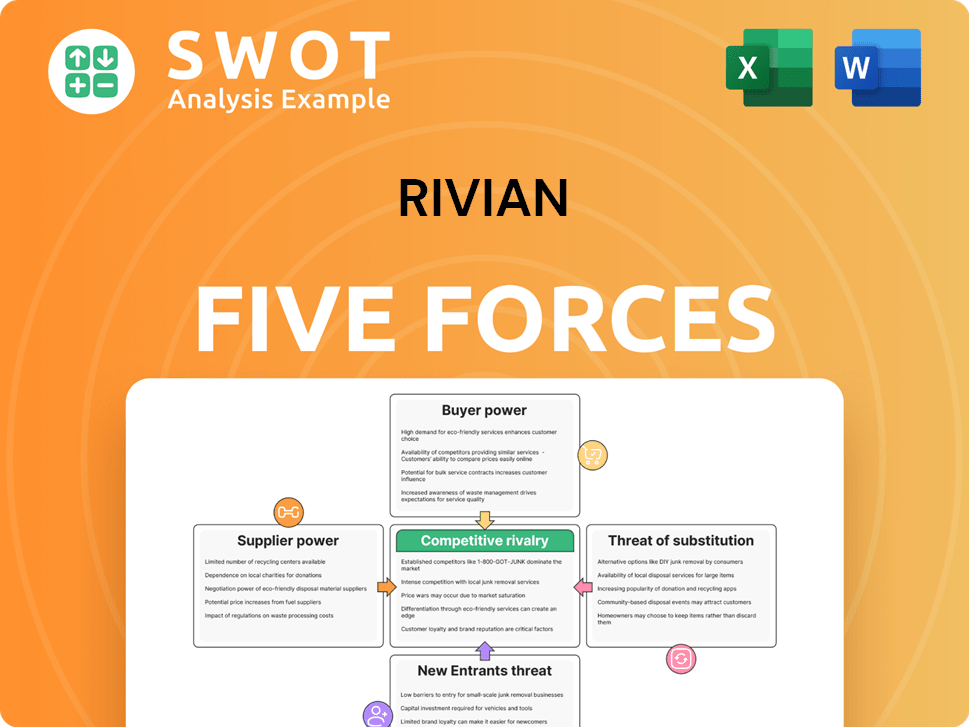
Related Blogs
- What are Mission Vision & Core Values of Rivian Company?
- What is Competitive Landscape of Rivian Company?
- What is Growth Strategy and Future Prospects of Rivian Company?
- How Does Rivian Company Work?
- What is Brief History of Rivian Company?
- Who Owns Rivian Company?
- What is Customer Demographics and Target Market of Rivian Company?
Disclaimer
All information, articles, and product details provided on this website are for general informational and educational purposes only. We do not claim any ownership over, nor do we intend to infringe upon, any trademarks, copyrights, logos, brand names, or other intellectual property mentioned or depicted on this site. Such intellectual property remains the property of its respective owners, and any references here are made solely for identification or informational purposes, without implying any affiliation, endorsement, or partnership.
We make no representations or warranties, express or implied, regarding the accuracy, completeness, or suitability of any content or products presented. Nothing on this website should be construed as legal, tax, investment, financial, medical, or other professional advice. In addition, no part of this site—including articles or product references—constitutes a solicitation, recommendation, endorsement, advertisement, or offer to buy or sell any securities, franchises, or other financial instruments, particularly in jurisdictions where such activity would be unlawful.
All content is of a general nature and may not address the specific circumstances of any individual or entity. It is not a substitute for professional advice or services. Any actions you take based on the information provided here are strictly at your own risk. You accept full responsibility for any decisions or outcomes arising from your use of this website and agree to release us from any liability in connection with your use of, or reliance upon, the content or products found herein.